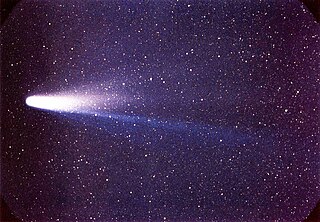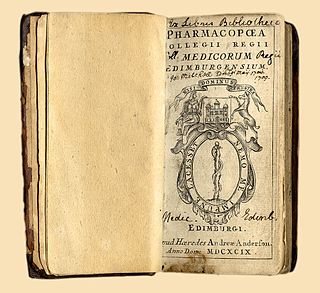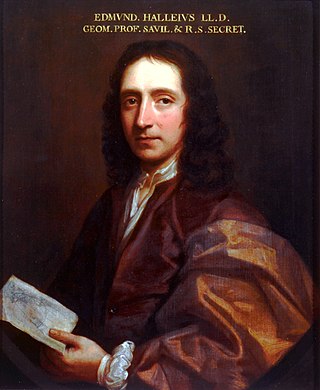Related Research Articles

A comet is an icy, small Solar System body that warms and begins to release gases when passing close to the Sun, a process called outgassing. This produces an extended, gravitationally unbound atmosphere or coma surrounding the nucleus, and sometimes a tail of gas and dust gas blown out from the coma. These phenomena are due to the effects of solar radiation and the outstreaming solar wind plasma acting upon the nucleus of the comet. Comet nuclei range from a few hundred meters to tens of kilometers across and are composed of loose collections of ice, dust, and small rocky particles. The coma may be up to 15 times Earth's diameter, while the tail may stretch beyond one astronomical unit. If sufficiently close and bright, a comet may be seen from Earth without the aid of a telescope and can subtend an arc of up to 30° across the sky. Comets have been observed and recorded since ancient times by many cultures and religions.

1618 (MDCXVIII) was a common year starting on Monday of the Gregorian calendar and a common year starting on Thursday of the Julian calendar, the 1618th year of the Common Era (CE) and Anno Domini (AD) designations, the 618th year of the 2nd millennium, the 18th year of the 17th century, and the 9th year of the 1610s decade. As of the start of 1618, the Gregorian calendar was 10 days ahead of the Julian calendar, which remained in localized use until 1923.

1680 (MDCLXXX) was a leap year starting on Monday of the Gregorian calendar and a leap year starting on Thursday of the Julian calendar, the 1680th year of the Common Era (CE) and Anno Domini (AD) designations, the 680th year of the 2nd millennium, the 80th year of the 17th century, and the 1st year of the 1680s decade. As of the start of 1680, the Gregorian calendar was 10 days ahead of the Julian calendar, which remained in localized use until 1923.

Year 1554 (MDLIV) was a common year starting on Monday of the Julian calendar.

1682 (MDCLXXXII) was a common year starting on Thursday of the Gregorian calendar and a common year starting on Sunday of the Julian calendar, the 1682nd year of the Common Era (CE) and Anno Domini (AD) designations, the 682nd year of the 2nd millennium, the 82nd year of the 17th century, and the 3rd year of the 1680s decade. As of the start of 1682, the Gregorian calendar was 10 days ahead of the Julian calendar, which remained in localized use until 1923.

Halley's Comet is the only known short-period comet that is consistently visible to the naked eye from Earth, appearing every 72–80 years, though with the majority of recorded apparations occurring after 75–77 years. It last appeared in the inner parts of the Solar System in 1986 and will next appear in mid-2061. Officially designated 1P/Halley, it is also commonly called Comet Halley, or sometimes simply Halley.

John Bainbridge was an English astronomer and mathematician.

A pharmacopoeia, pharmacopeia, or pharmacopoea, in its modern technical sense, is a book containing directions for the identification of compound medicines, and published by the authority of a government or a medical or pharmaceutical society.
The year 1866 in science and technology involved some significant events, listed below.
The year 1831 in science and technology involved some significant events, listed below.
The year 1835 in science and technology involved some significant events, listed below.
The year 1788 in science and technology involved some significant events.
The Kreutz sungrazers are a family of sungrazing comets, characterized by orbits taking them extremely close to the Sun at perihelion. At the far extreme of their orbits, aphelion, Kreutz sungrazers can be a hundred times farther from the Sun than the Earth is, while their distance of closest approach can be less than twice the Sun's radius. They are believed to be fragments of one large comet that broke up several centuries ago and are named for German astronomer Heinrich Kreutz, who first demonstrated that they were related. These sungrazers make their way from the distant outer Solar System to the inner Solar System, to their perihelion point near the Sun, and then leave the inner Solar System in their return trip to their aphelion.
The British Pharmacopoeia (BP) is the national pharmacopoeia of the United Kingdom. It is an annually published collection of quality standards for medicinal substances in the UK, which is used by individuals and organisations involved in pharmaceutical research, development, manufacture and testing.

John Parkinson was the last of the great English herbalists and one of the first of the great English botanists. He was apothecary to James I and a founding member of the Worshipful Society of Apothecaries in December 1617, and was later Royal Botanist to Charles I. He is known for two monumental works, Paradisi in Sole Paradisus Terrestris, which generally describes the proper cultivation of plants; and Theatrum Botanicum, the most complete and beautifully presented English treatise on plants of its time. One of the most eminent gardeners of his day, he kept a botanical garden at Long Acre in Covent Garden, today close to Trafalgar Square, and maintained close relations with other important English and Continental botanists, herbalists and plantsmen.
Events from the 1550s in England. This decade marks the beginning of the Elizabethan era.
George Bate (1608–1668) was an English court physician.
The year 1554 CE in science and technology included a number of events, some of which are listed here.

EdmondHalley was an English astronomer, mathematician and physicist. He was the second Astronomer Royal in Britain, succeeding John Flamsteed in 1720.
Prof Clare Fowler CBE is a British physician and academic who created the subspecialty of uro-neurology, a medical field that combines urology and neurology. This work was done at the Institute of Neurology, University College London, where she is an emeritus professor.
References
- ↑ Miller, Arthur I. (2009). Deciphering the cosmic number: the strange friendship of Wolfgang Pauli and Carl Jung . New York: W. W. Norton & Co. p. 80. ISBN 978-0-393-06532-9 . Retrieved March 7, 2011.
- ↑ Ereira, Alan (2016). The Nine Lives of John Ogilby. Duckworth. p. xxi. ISBN 9780715652268.
- ↑ Medicorum Collegij Londinensis. Pharmacopœia Londinensis in qua medicamenta antiqua et nova vsitatissima, sedulò collecta, accuratissimè examinata, quotidiana experientia confirmata describuntur. Opera Medicorum Collegij Londinensis. Ex serenissimi Regis mandato cum R.M. Priuilegio. Printed by Edwardus Griffin for Iohannis Marriot.See: "Treasures of the Royal Pharmaceutical Society's collections: Pharmacopoeia Londinensis 1618 (The London Pharmacopoeia)". The Pharmaceutical Journal . 273. London: Royal Pharmaceutical Society of Great Britain: 299. August 28, 2004. ISSN 0031-6873.